|

Qi Zheng |
PORCELAIN CARVING
08/ 02
~27/
02
2011
Porcelain carving is a craft in which a diamond or a tungsten
steel cutter is used to carve a variety of beautiful patterns and
inscriptions on the surface of porcelain, which is then fired under
high temperatures. Unique carving techniques produce landscapes,
characters, insects, animals, and even calligraphy. Impressing artistic
circles, practitioners of porcelain carving have recently favoured
black porcelain. The black colour of the material accentuates
the contrast between light and shade, and delicately articulates
different layers on three-dimensional surfaces.
Qi Zheng prefers to utilize discerning black porcelain as her
raw material. Her works convey a natural and exquisite quality,
shaped by her innovative cutting skills. In 1996, she was honoured
with the title ‘National Folk and Crafts Artist’ by UNESCO and
the China Folk Artists Association. She also organised her own
porcelain-carving exhibition in the National Contemporary Art
Museum of China and has conducted cultural exchanges overseas.. |
| |
|

Qi Xiuhua |
GAOMI PAPER-CUTTINGS
08 / 02 ~ 27 / 02
2011
Since the reign of Emperor Hongwu of the Ming Dynasty,
Gaomi Paper-Cuttings—famous for their strong and clearly defined
lines—have gradually established themselves as a significant art
form. Blossoming during the Qing Dynasty, Gaomi Paper-Cutting
embraces a wide range of themes, and is regarded as one of the ‘Four
Treasures” of Gaomi City in Shandong Province. The craft is also
included in the National Preservation Scheme of Intangible Cultural
Heritage.
Qi Xiuhua, a representative of the Intangible Cultural Heritage
at the provincial level, founded the Qi Xiuhua Paper-Cutting
Research Institute. Highly acclaimed, her works earned her the
honour of being named ‘Outstanding Inheritor of Chinese Folk
Culture’ of Shandong Province in 2007. In 2009, Qi was additionally
recognised as an ‘Arts and Crafts Master’ at the provincial level.
Her work “Golden Ox Jumping on Hoof” was featured on the 1997
Chinese zodiac commemorative stamp issued by the China Post. |
| |
|
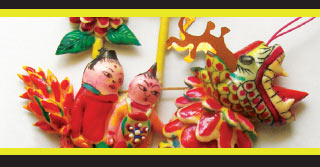
Su Haimin |
ZISHA POTTERY
01/ 03
~20/03
2011
Originally from Langzhuang Village, located in Beiguantao
Town in Guan County, Shandong Province, the distinctive
Langzhuang dough figurine sculptures are locally known as ‘dough
tigers’. As a prototype of dough modelling art in the northwestern
region of Shandong, these sculptures are rich in cultural context.
Langzhuang dough figurine sculptures are moulded in semi-relief
style. After steaming, the dough models expand and showcase their
unique kind of beauty. In addition, the use of contrasting colours
makes the steamed dough figurine sculptures vividly come to life.
Su Haimin belongs to a new generation of Langzhuang
dough figurine artisans. Her figurines are simple and vigorous, yet
deliberately exaggerated. Su learned the art of dough modelling
from Lang Xiucai, and in 2010 participated in the Shandong Activity
Week of the Shanghai World Expo and the first China National
Intangible Cultural Heritage Expo. She was warmly welcomed and
enthusiastically acclaimed in both events. |
| |
|
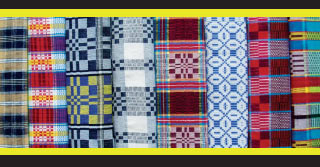
Liu Aiyu |
LU BROCADE
01 / 03 ~ 20 / 03
2011
Lu Brocade is commonly known as a specific type of jacquard
fabric that is manually woven from pure cotton. This folk textile,
distinctive to southwest Shandong Province, is named after its
blooming colours, which are skilfully woven into refined patterns.
These exquisite and quaint patterns are brilliantly coloured, finely
woven and very durable. The weaving technique is extremely
complicated, allowing imagination and craftsmanship to produce
an extraordinary variety of bright and appealing patterns. In
2008, this weaving technique was inscribed on the list of National
Intangible Cultural Heritage.
Highly proficient in various weaving methods, Liu Aiyu
constantly explores new and innovative techniques that allow her
to transcend the original models. Liu participated in the Exhibition
of Chinese Intangible Cultural Heritage & Traditional Folk Crafts in
2009, and in the first China National Intangible Cultural Heritage
Expo in 2010. |
| |
|
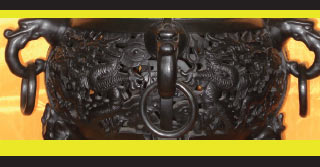
Zhang Guoqing |
LONGSHAN BLACK POTTERY
22 / 03 ~ 10 / 04
2011
Shandong Longshan Culture has its origins in the late
Neolithic Age, dating back to more than 4000 years.
Since many of the excavated archaeological relics are black
pottery, Longshan Culture is commonly referred to as ‘Black Pottery
Culture’. The carbonisation method employed during the process
of firing the pottery produces characteristic ‘dark, thin and shiny
artefacts with a clear and melodious sound’. This ‘eggshell black
pottery’ - a type of pottery with a thin wall and a glossy black finish–
embodies the essence and outstanding achievements of Longshan
Black Pottery.
Based on the experiences of his predecessor and information
gathered from excavated relics, Zhang Guoqing expertly restored
an eggshell pottery cup originally made during the Longshan Era.
In July 2007, Zhang was honoured with the title ‘Arts and Crafts
Master of Shandong Province’. |
| |
|
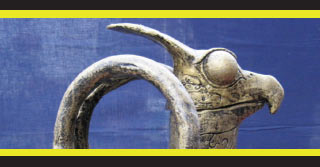
Gan Zhiyao |
FULI CLAY POTTERY
22/03 ~ 10
/04
2011
Shandong clay pottery is categorised according to its function
in rituals, appreciation, daily necessities and value. Altogether, 39
kinds of clay pottery were discovered in Fuli Village (Xiji Town),
Shanting District, in Shandong Province. Based on these discoveries
in the village and in tombs from the Han, Tang, Ming and Qing
dynasties, the history of clay pottery production dates back to
more than 6000 years. Clay pottery fashioned by primitive societies
in the Neolithic Age bears a strong resemblance to the clay ware
produced during the Han dynasty, suggesting that they absorbed
the artistic conceptions of the Ming and Qing dynasties as well.
Since 1978, Gan Zhiyao has dedicated his life to the
excavation, sorting and restoration of folk clay pottery in Fuli Village.
He is the director of the Fuli Clay Pottery Art Research Institute—an
institution he founded—and oversees the excavation, research and
inheritance work of Fuli clay pottery. In 1995, Gan was honoured
with the title ‘National Folk Arts & Crafts Artist’ by UNESCO. |
| |
|
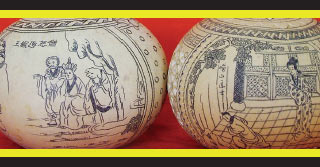
Li Yucheng
|
GOURD CARVING
12
/04~24/04
2011
Originating in Dongchang District, Liaocheng City in
Shandong Province, gourd carving is considered a National
Intangible Cultural Heritage. Carvings are classified into two main
categories according to function – appreciation and practical use.
Gourds for appreciation sport patterns including drama characters,
flowers and birds in flat or openwork engravings and embossments.
Practical applications include wine gourds, medicine gourds, gourd
tea-sets, tableware and penholders.
Li Yucheng is an heir of the Intangible Cultural Heritage of
Shandong Province. Li’s engravings are highly acclaimed for his
use of smooth and natural lines in simple yet lively designs, and his
rich themes. His engraving techniques gradually developed from
single engravings to the combined use of pyrographs, carving and
incision. Similarly, instead of relying on a single black colour, he
presently employs multiple colours, thereby significantly enriching
the presentation as well as the charm of his gourd carvings. |
| |
|
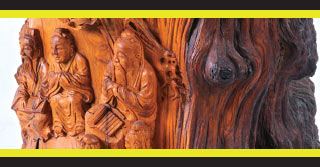
Kong Fanbiao |
CONFUCIAN KAI WOOD CARVING
12/ 04 ~
24 / 04
2011
The hometown of Confucius, Qufu City in Shandong Province,
boasts a rich cultural heritage. Confucian Kai Wood Carving has
an extended history and embodies the Confucian ideas of ‘virtue,
righteousness, rite, wisdom and integrity’. The primary materials
of for Kai Wood carvings are cane and ruyi. The Kai tree is a very
rare species which can grow for over a thousand years. This tree
produces hard but refined wood, with a beautiful golden colour.
Thus, the tree is also known as ‘Soft Gold’ and variously called
‘Sandalwood’ in the South and ‘Kai’ in the North.
Kong Fanbiao is the fifth direct-line inheritor of Qufu Kai
Wood Carving and a successor of Kai Wood Carving. Kong’s works
are meticulously crafted and engraved with love and affection.
After long and devoted study, Kong now practices four types
of engraving techniques—round engraving, relief engraving,
openwork engraving and incision—drawing together a strong
sense of cultural heritage. |
BACK |







